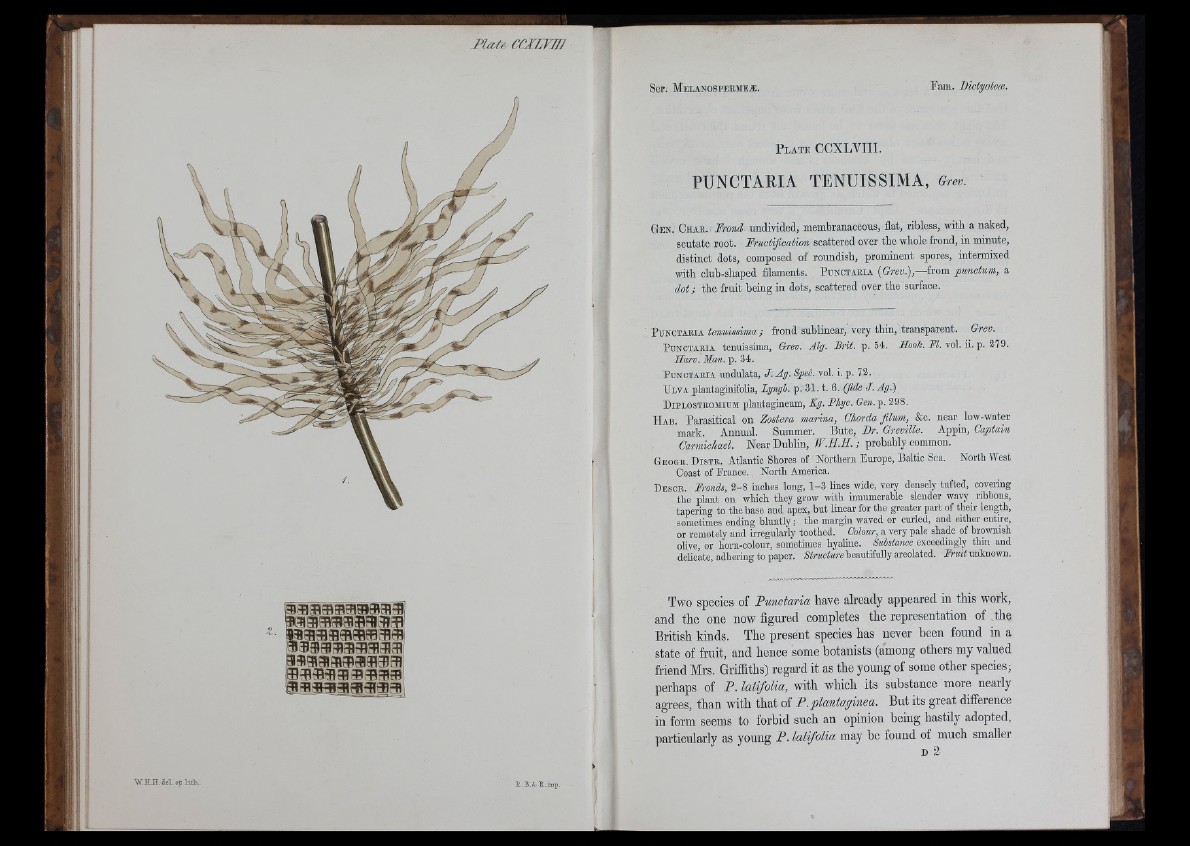
: a i:
ii ' ‘
li
CÜOEl ® ®OOE tîOEj rloCrQnCc ttftiIlinCIl^
'— mmm
P la t e CCXLVIIl.
PUNCTARIA TENUISSIMA, Grev.
Gen. Ch a e . Frond u n d iv id ed , membranaceous, flat, ribless, w ith a n aked,
s cu ta te ro o t. Fructification sca tte red over th e whole frond, in m in u te ,
d is tin c t dots, composed of ro u n d ish , p rom in en t spores, in te rm ix ed
w ith c lu b -sh ap ed fllaments. P unotaeia (Grev.),— from
d o t; th e fru it b e in g in dots, s c a tte red over th e surface.
P u n o t a e i a tenuissima; frond sublinear, very thin, transparent. Grev.
PU N C TA IIIA tenuissima, Grev. Alg. Brit. p. 54. Hook. M. vol. ii. p. 379.
Harv. Man. p. 34.
P u n o t a e i a undulata, J. Ag. Spec. vol. i, p. 73.
U lv a plantaginifolia, Lyngh, p. 31. t. 6. (fide J.A g.)
U iP L O S T E O M iU M plantagineum. Kg. Fliyc. Gen. p. 398.
H a b . Parasitical on Zostera marina, Chorda filum, &c. near low-water
mark. Annual. Summer. Bute, Dr. Greville. Appin, Captain
Carmichael. Near Dublin, W .E .H .; probably common.
G e o g e , D i s t e . Atlantic Shores of N o r t h e r n Europe, Baltic Sea. North West
Coast of France. North America.
D e s c e . Fronds, 3 -8 inches long, 1 -3 lines wide, very densely tufted, covering
the plant on which they grow with innumerable slender wavy ribbons,
tapering to the base and apex, b u t linear for the greater part of their length,
sometimes ending b lu n tly ; the margin waved or curled, and either entire,
or remotely and m-egularly toothed. Colour, a very pale shade of brownish
olive, or horn-colour, sometimes hyaline. Substance exceedingly thin and
delicate, adhering to paper. Structure beautifully areolated. Fruit unknown.
Two species of Punctaria have already appeared in this work,
and the one now figured completes the representation of the
British kinds. The present species has never been found in a
state of fruit, and hence some botanists (among others my valued
friend Mrs. Griffiths) regard it as the young of some other species;
perhaps of P . latifolia, with which its substance more nearly
agrees, than with that of P.plantaginea. But its great difference
in form seems to forbid such an opinion being hastily adopted,
particularly as young P. latifolia may be found of much smaller
D 2